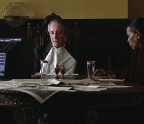Distant Lives GRIEF AND PROTOCOL IN THE QUEEN

In May 1997, Tony Blair won a landslide general election victory for Labour, ending his party’s eighteen years in opposition.1 Less than four months later, on 31 August 1997, Diana, Princess of Wales, died as a consequence of injuries sustained in a car accident in the Pont de l’Alma road tunnel in Paris, France.2 The Queen (Stephen Frears, 2006) portrays the British Royal Family’s response to Diana’s death, and the role that former prime minister Blair played in negotiating public grief and royal protocol.
The Queen is a recommended narrative film for study in senior English and Media classes. It is classified M and has a running time of 103 minutes.
Power
In a sequence that occurs near the beginning of The Queen, Tony Blair (Michael Sheen), the popular and newly elected prime minister, visits Buckingham Palace for his first meeting with Queen Elizabeth II (Helen Mirren), accompanied by his wife, Cherie (Helen McCrory).
It is the Queen’s role after a general election to ask the leader of the majority party to form a new government. Despite Blair’s preparation, nerves get the better of him as he is ushered into an audience room for his first weekly meeting with her. In response to the Queen’s dry sense of humour and her aloof reminder of the longevity of her reign, he blunders his way through the simple ceremony.
The dialogue in the opening scene of , in which Elizabeth poses for an official portrait, has already established Blair as a ‘moderniser’. Frears uses the portrait artist, a staunch monarchist, to give a voice to the fear of change that will become apparent later in the film when the Queen is reluctant to replace old protocols with new. In addition, the scene initiates the exploration of the film’s key idea of power: the Queen may not be allowed to vote, but, as the portrait artist reminds her, it is still her government. In
You’re reading a preview, subscribe to read more.
Start your free 30 days





